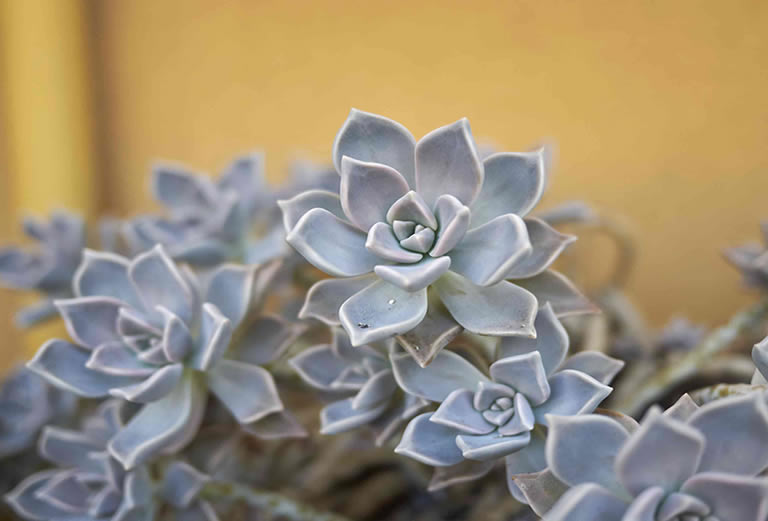Don’t let the name fool you—Ghost Plant (Graptopetalum paraguayense) is anything but spooky. With its trailing rosettes of silvery-pink to soft lavender leaves and sculptural, cascading form, this succulent brings a dreamy, ethereal vibe to any plant collection. It’s also incredibly easygoing and adaptable, making it a favorite for both beginners and seasoned succulent lovers.
Whether you’re growing it in a container, mixed succulent arrangement, or letting it spill gracefully over a sunny windowsill, Ghost Plant adds delicate drama wherever it goes.
Let’s walk through everything you need to know to help your Graptopetalum thrive.
Table of Contents
- Where Ghost Plant Comes From
- What Makes Ghost Plant Special
- When Ghost Plant Blooms: A Delicate Surprise
- A Look at the Most Popular Varieties
- Light Requirements
- Soil Needs
- Watering Requirements
- Temperature and Humidity
- Fertilizing Your Ghost Plant
- Pruning and Grooming
- Propagation: One of the Easiest Ever
- Growing Ghost Plant Outdoors
- Common Issues
- Is Ghost Plant Pet Safe?
Where Ghost Plant Comes From
Ghost Plant is native to the arid mountains of northeastern Mexico, where it grows in rocky, sun-drenched landscapes.
It belongs to the Crassulaceae family, along with other popular succulents like Echeveria and Sedum.
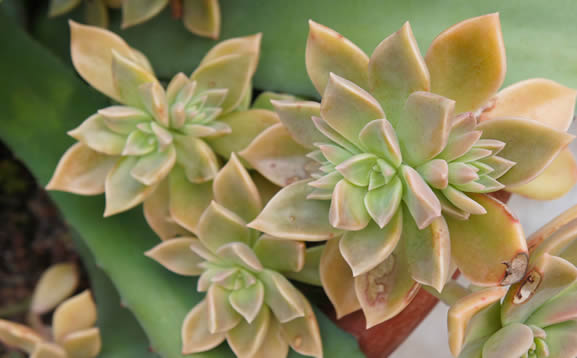
Because of its origin, Ghost Plant is extremely drought-tolerant and loves bright light.
It’s also surprisingly cold-hardy for a succulent—making it a great option for outdoor gardens in warmer regions.
What Makes Ghost Plant Special
What sets Ghost Plant apart is its color-shifting foliage.
Depending on light, temperature, and soil, its thick, pointed leaves can range from pale blue to silvery-gray, pink, or even slightly peachy.
The rosettes grow on long, trailing stems that can drape beautifully or root where they touch the ground, making it a great spiller in containers or ground cover in gardens.
It also produces small, star-shaped white flowers with red speckles—another charming bonus.
When Ghost Plant Blooms: A Delicate Surprise
While its foliage steals the spotlight, Ghost Plant also produces charming little star-shaped flowers—usually in late spring or early summer.
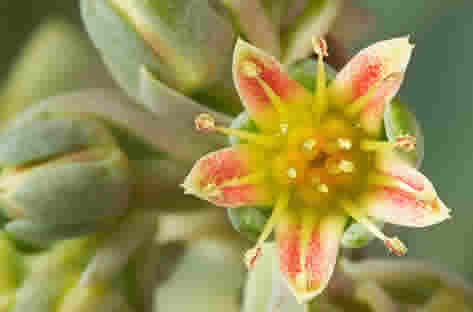
The blooms are typically white or pale yellow, dotted with tiny red or orange speckles, and appear on long, slender stalks that rise above the rosettes.
They’re not only beautiful but also a magnet for pollinators like bees.
A Look at the Most Popular Varieties
Graptopetalum paraguayense isn’t a one-style-fits-all kind of plant—there are several captivating cultivars, each with its own color palette, leaf shape, or charming detail.
If you’re looking to expand your succulent collection, these are the most popular varieties to know.
Graptopetalum paraguayense ‘Fantasma’
Often considered the “true” Ghost Plant, ‘Fantasma’ features pale gray-lavender rosettes with a soft, powdery coating.
Its color deepens with more sun exposure, and it’s a classic for both containers and rock gardens.
Graptopetalum paraguayense ‘Bernalense’
This variety is more compact, with tighter rosettes and a stronger bluish hue.
It’s great for arrangements where space is limited but you still want something eye-catching.
Graptopetalum paraguayense ‘Variegata’
A real showstopper, ‘Variegata’ features gorgeous cream, pink, and soft green marbling across the leaves.
It’s slower-growing and a bit more delicate but absolutely worth the extra care.
Graptopetalum paraguayense ‘Peach’
This one earns its name from its soft pink-peach coloration, especially when grown in full sun.
Its subtle warmth makes it perfect for pastel-themed succulent gardens.
Graptopetalum paraguayense ‘Awayki’
‘Awayki’ has a slightly more stretched-out rosette and a soft lilac tint.
It’s a newer favorite among collectors for its elegant shape and muted tones.
Graptopetalum paraguayense ‘Jester’
One of the more whimsical cultivars, ‘Jester’ often shows playful color variation—greens, purples, and hints of pink—depending on light exposure.
It’s a fun one to watch change with the seasons.
Graptopetalum paraguayense ‘Dibujo’
Translating to “drawing” or “sketch,” this variety has a delicate, artistic look with fine leaf markings and soft pastel tones.
It brings a painterly quality to arrangements.
Graptopetalum paraguayense ‘Flor’
Noted for its especially pretty flowering habit, ‘Flor’ blooms with showy, star-shaped blossoms that contrast beautifully against its pale foliage.
It’s a solid choice if you’re after blooms as much as foliage.
Graptopetalum paraguayense ‘Cuidados’
While not a variety name in the traditional sense, “cuidados” (Spanish for “care”) often appears in plant listings to indicate general Ghost Plant care information.
It’s worth noting in case you see it on plant tags or nursery listings.
Graptopetalum paraguayense ‘Variedades’
This simply means “varieties” in Spanish and may refer to a mixed or assorted tray of Graptopetalum types.
Great for discovering new favorites or starting a collection.
Light Requirements
Ghost Plant loves the sun. Give it bright, direct light for at least 4–6 hours a day. Indoors, a sunny south- or west-facing window is ideal.
If it’s not getting enough light, you’ll notice stretching (etiolation) as it reaches for the sun.
When grown outdoors, it truly shines—literally.
Exposure to full sun can deepen its color and keep it compact and vibrant.
Soil Needs
Like most succulents, Ghost Plant needs excellent drainage.
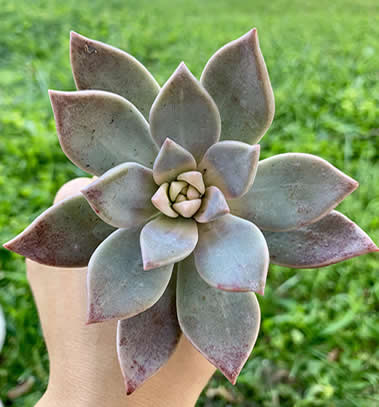
A gritty cactus or succulent mix is perfect.
You can also make your own by combining:
-
2 parts potting soil
-
1 part coarse sand
-
1 part perlite or pumice
Avoid soil that stays wet or compacted—this plant does not like soggy roots.
Watering Requirements
Water your Ghost Plant using the soak-and-dry method.
Wait until the soil is bone dry, then water deeply until it drains from the bottom.
Always empty excess water from saucers and avoid getting water trapped between the rosette leaves.
In spring and summer (its active growing season), you’ll likely water every 2–3 weeks indoors.
In winter, once a month or less is often enough.
Signs of underwatering: wrinkled leaves.
Signs of overwatering: mushy, transparent leaves or black spots.
Temperature and Humidity
Ghost Plant is more cold-tolerant than many succulents.
It can handle temps down to around 20°F if kept dry—though in colder zones, it should be overwintered indoors.
Ideal temperatures range from 60°F to 85°F.
It prefers low humidity, making it perfect for dry indoor air or desert climates.
Fertilizing Your Ghost Plant
This plant doesn’t need much feeding.
In spring and summer, you can fertilize once a month using a diluted succulent fertilizer. Use a good cacti feed, like this one.
Skip feeding in fall and winter when growth slows.
Over-fertilizing can cause leggy growth or leaf drop—so when in doubt, skip it.
Pruning and Grooming
Ghost Plant’s long, trailing stems can be pruned to maintain shape or encourage bushier growth.
Use clean scissors to trim back leggy stems, and feel free to use the cuttings for propagation (more on that in a second!).
Remove any shriveled or dried lower leaves to keep the plant tidy and encourage airflow.
Propagation: One of the Easiest Ever
This plant is a propagation rockstar. Almost every leaf or stem cutting will root with minimal effort.
How to propagate Ghost Plant:
-
Gently remove a healthy leaf and let it callous over for a day or two.
-
Place it on top of dry succulent soil and mist lightly every few days.
-
In a couple of weeks, roots and tiny baby rosettes will form.
You can also take stem cuttings, let them dry for a day, and replant.
Even dropped leaves or broken pieces often root on their own when left on soil.
Propagation works year-round but is fastest in spring and summer.
If you want more in-depth step-by-step instructions read our article How to Propagate Ghost Plant (Graptopetalum paraguayense): Multiply the Magic of This Soft-Toned Succulent.
Growing Ghost Plant Outdoors
If you’re in USDA zones 9–11, Ghost Plant is an excellent option for outdoor growing.
Even in cooler zones, it can enjoy a summer vacation outside.
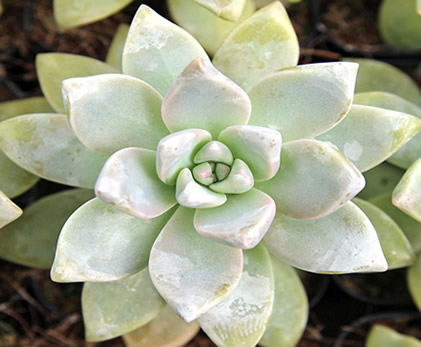
Tips for outdoor growing:
-
Plant in full sun or light shade (a little afternoon shade helps in extremely hot regions).
-
Use well-draining soil—raised beds, gravel paths, or rock gardens are perfect.
-
Avoid overwatering, especially during rainy seasons. If needed, plant on a slope to improve drainage.
-
Ghost Plant works beautifully as ground cover, between stones, or spilling from walls and containers.
-
In frost-prone areas, grow it in pots you can bring inside before cold weather hits.
Bonus tip: Outdoor Ghost Plants often develop more vivid color and produce more offsets thanks to sun and seasonal rhythms.
Common Issues
-
Legginess: Caused by not enough light. Move it to a sunnier spot.
-
Soft, translucent leaves: A sign of overwatering.
-
Leaf drop: Can happen with overwatering, sudden temperature drops, or transplant shock—but usually bounces back.
-
Pests: Rare, but mealybugs can occasionally hide in crevices. Treat with neem or insecticidal soap if needed.
Is Ghost Plant Pet Safe?
Yes! Ghost Plant is considered non-toxic to cats, dogs, and humans. Still, it’s best to keep out of reach of curious nibblers, especially since the trailing stems can be fragile.
Final Thoughts
Ghost Plant (Graptopetalum paraguayense) is proof that low-maintenance can still be jaw-droppingly beautiful.
With its pastel colors, sculptural form, and easy propagation, it’s one of those plants that quietly takes over your heart—and maybe your whole shelf.
Let me know if you’d like this turned into a printable care card, infographic, or companion propagation guide.
And when you’re ready for the next plant feature, I’m just a message away!

